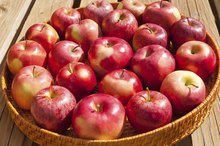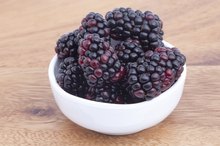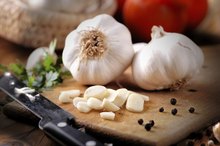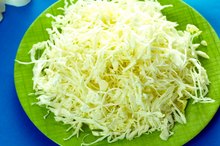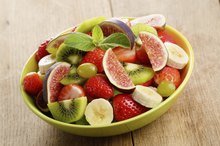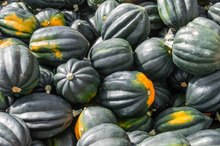Types of High Soluble Fiber in Lettuce
A type of carbohydrate or starch that your body cannot digest, dietary fiber exists only in plant foods 1. It regulates your digestion, sweeping out the intestines and adding bulk to your stool. Fruits, whole grains and vegetables, including lettuce, are sources of fiber. The fiber in lettuce is both soluble and insoluble.
Soluble Vs. Insoluble Fiber
Two types of fiber are found in plant products: soluble and insoluble. Plant cells contain water-soluble fibers, meaning they dissolve in water to become a soft gel. Soluble fiber helps your body by binding with cholesterol and removing it from your bloodstream 1. It can also help firm your stool and slow digestion to keep blood sugar levels more stable. Insoluble fiber passes quickly through your gut, preventing constipation and gut infections. By warding off constipation, it can also help prevent hemorrhoids. Find insoluble fiber primarily in fruit with edible skins, raw vegetables, nuts, beans and whole grains.
- Two types of fiber are found in plant products: soluble and insoluble.
- Plant cells contain water-soluble fibers, meaning they dissolve in water to become a soft gel.
Types of Soluble Fiber
Water Soluble Fiber Foods
Learn More
Soluble fiber can further be broken down into types: beta-glucan, found mainly in grains; pectin, sugar acids mainly found in fruit and sweet vegetables; natural gums, including guar, locust bean, gum acacia, carrageenan and xanthan; and inulin, present in onions, chicory and wheat. Radicchio lettuce is rich in inulin, while butter lettuce is not. Other lettuces may contain some pectin and inulin, but the exact ratios depend on the type.
- Soluble fiber can further be broken down into types: beta-glucan, found mainly in grains; pectin, sugar acids mainly found in fruit and sweet vegetables; natural gums, including guar, locust bean, gum acacia, carrageenan and xanthan; and inulin, present in onions, chicory and wheat.
- Other lettuces may contain some pectin and inulin, but the exact ratios depend on the type.
Lettuce as Fiber
Lettuce isn't high in fiber when compared to other produce. Romaine lettuce, for example, contains 1.2 grams of fiber per cup, while iceberg has only 0.7 gram per cup. Compare this to higher-fiber options, such as a pear with 5.1 grams, 1 cup of green beans with 4 grams or half of a sweet potato with 3.9 grams. The National Academy of Nutrition and Dietetics recommends you get between 20 and 35 grams of fiber per day from a variety of sources to promote good health.
- Lettuce isn't high in fiber when compared to other produce.
- Compare this to higher-fiber options, such as a pear with 5.1 grams, 1 cup of green beans with 4 grams or half of a sweet potato with 3.9 grams.
Complications
Side Effects of Pectin
Learn More
Most people should seek to eat more fiber, of any kind, to promote good digestive health. However, those who experience certain digestive disorders, including irritable bowel syndrome or Crohn's disease, may shy away from fiber altogether. They also may find that certain types of fiber, such as inulin, cause their symptoms to intensify, so they need to avoid it. Unfortunately, determining your trigger foods is individual; some lettuces may cause digestive distress, while others are perfectly digestible for you. A food diary may help you identify your personal triggers; sometimes it isn't the lettuce in a salad you've eaten that's caused a problem but other vegetables that you've added.
- Most people should seek to eat more fiber, of any kind, to promote good digestive health.
- They also may find that certain types of fiber, such as inulin, cause their symptoms to intensify, so they need to avoid it.
Related Articles
References
- Today's Dietitian: A Soluble Fiber Primer -- Plus the Top Five Foods That Can Lower LDL Cholesterol
- Today's Dietitian: The FODMAPs Approach -- Minimize Consumption of Fermentable Carbs to Manage Functional Gut Disorder Symptoms
- University of Maryland Medical Center: Fiber
- Dahl WJ, Stewart ML. Position of the Academy of Nutrition and Dietetics: Health Implications of Dietary Fiber. J Acad Nutr Diet. 2015 Nov;115(11):1861-70. doi: 10.1016/j.jand.2015.09.003.
- Francesca De Filippis, et.al. High-level adherence to a Mediterranean diet beneficially impacts the gut microbiota and associated metabolome. Gut, 2015; gutjnl-2015-309957 DOI: 10.1136/gutjnl-2015-309957
- Harvard School of Public Health. http://www.hsph.harvard.edu/nutritionsource/carbohydrates/fiber/
- University of Maryland Medical Center. http://umm.edu/health/medical/altmed/supplement/fiber
- USDA.http://www.ers.usda.gov/topics/
Writer Bio
Andrea Boldt has been in the fitness industry for more than 20 years. A personal trainer, run coach, group fitness instructor and master yoga teacher, she also holds certifications in holistic and fitness nutrition.
